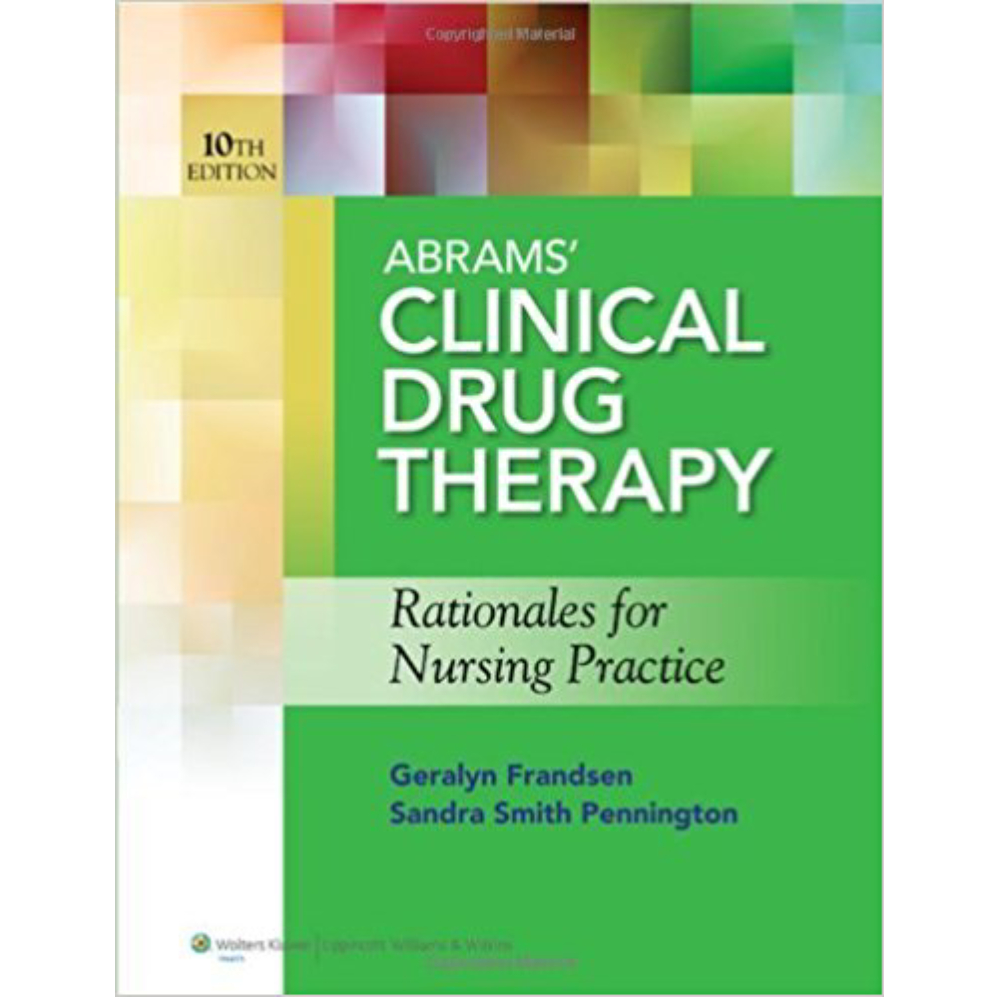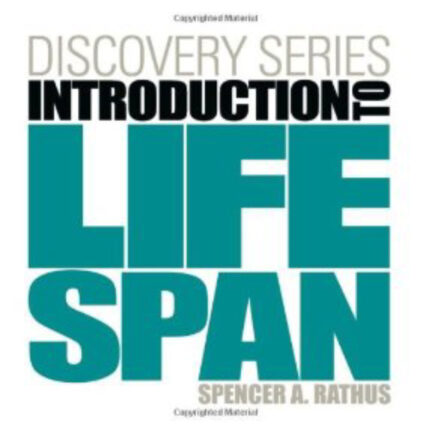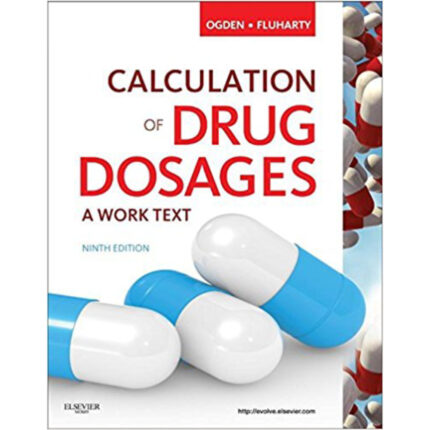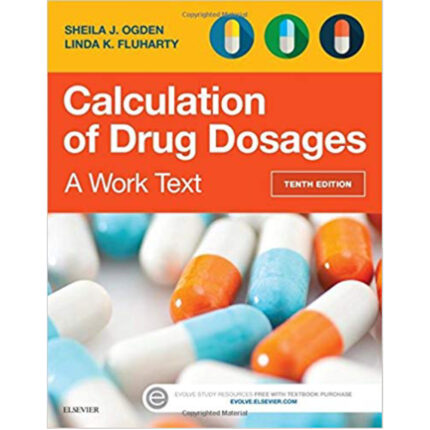Abrams’ Clinical Drug Therapy Rationales For Nursing Practice 10th Edition By Geralyn – Test Bank
1. Which of the following is the most likely indication for the use of immunosuppressant agents?
A) Intractable seizure disorders
B) Increased intracranial pressure
C) Organ transplantation
D) HIV/AIDS with multiple drug resistance
Ans: C
Feedback:
Immunosuppressant agents are used for inflammatory autoimmune disorders or to prevent or treat tissue rejection reactions in organ transplantation. Immunosuppressant agents are not administered for seizure disorders, increased intracranial pressure, or HIV/AIDS.
2. A patient has received a bone marrow transplant. What will occur if the patient receives inadequate immunosuppression after the transplant?
A) Graft-versus-host disease
B) Hepatotoxicity
C) Acute kidney injury
D) Sepsis
Ans: A
Feedback:
The goal after bone marrow transplantation is to provide adequate immunosuppression. If immunosuppression is inadequate, graft-versus-host disease will occur with bone marrow transplantation. The patient will not suffer from hepatic or renal failure. Inadequate immunosuppression will not place the patient at risk for serious infection.
3. A patient with Crohn’s disease is given a corticosteroid to decrease inflammation. Which of the following effects will occur with the use of corticosteroids?
A) Increased joint pain
B) Increased C-reactive protein levels
C) Increased T-cell counts
D) Decreased antibody production
Ans: D
Feedback:
The administration of corticosteroids will decrease T-cell and antibody production. Corticosteroids do not cause joint pain or increase a patient’s C-reactive protein levels.
4. A patient is to begin treatment for rheumatoid arthritis with infliximab (Remicade). What potential risk should the nurse identify as being associated with this drug?
A) Risk for infection
B) Risk for decreased level of consciousness
C) Risk for nephrotoxicity
D) Risk for hepatotoxicity
Ans: A
Feedback:
All TNF-alpha blockers carry a risk for infection. This risk supersedes the risks of kidney or liver damage. Changes in LOC are not typically noted.
5. A patient is administered mycophenolate (CellCept) to prevent rejection of his transplanted heart. It is recommended that he have a CBC drawn weekly. He asks the nurse the reason for the weekly CBC. Which of the following is the nurse’s best response?
A) “The weekly CBC is routine and ordered for all patients.”
B) “The weekly CBC assesses for the development of bleeding.”
C) “The weekly CBC assesses for the development of infection.”
D) “The weekly CBC assesses for changes in your blood’s oxygen carrying capacity.”
Ans: C
Feedback:
The weekly CBC is to assess for infection, neutropenia, and thrombocytopenia. Stating to the patient that the CBC is routine is a belittling response that does not provide patient education. The weekly CBC is not indicated to assess for bleeding or a decrease in erythrocytes.
6. A patient is administered cyclosporine (Sandimmune, Neoral) to prevent rejection of a kidney transplant. Which of the following is a major adverse effect of cyclosporine?
A) Congestive heart failure
B) Nephrotoxicity
C) Anaphylaxis
D) Respiratory arrest
Ans: B
Feedback:
The major adverse effect of cyclosporine is nephrotoxicity. Congestive heart failure is not noted as an adverse effect of cyclosporine. Anaphylaxis and respiratory arrest are not common adverse effects of cyclosporine.
7. A patient is receiving immunosuppressant therapy and is preparing for discharge. For which of the following should the patient be educated?
A) The importance of a high-protein diet
B) The need to maximize fluid intake
C) The need for regular physical activity
D) The importance of keeping the home clean
Ans: D
Feedback:
Meticulous environmental cleansing and personal and hand hygiene will protect from the development of serious infection. The importance of this infection control measure is greater than that of dietary or exercise guidelines.
8. A patient has been discharged from the hospital after a kidney transplant. Which of the following nursing interventions is the first line of defense against the immunosuppressed patient developing an infection?
A) Ensure visitors do not come to the home.
B) Teach the patient to wear a mask consistently.
C) Administer prophylactic antibiotics.
D) Teach the patient the importance of personal hygiene.
Ans: D
Feedback:
With patients who are taking immunosuppressant drugs, a major role of the home care nurse is to assess the environment for potential sources of infection, assist patients and other members of the household to understand the patient’s susceptibility to infection, and teach ways to decrease risks of infection. Meticulous environmental cleansing as well as personal and hand hygiene are required. Visitors do not necessarily need to be wholly barred from the home, and a mask is not always required. Prophylactic antibiotics are not normally used.
9. A patient has been placed on tacrolimus, and the route will be changed from IV to oral prior to discharge home from the hospital. How will this change in administration route affect the patient’s plan of care?
A) The patient’s dose of tacrolimus will have to be increased.
B) The patient will receive the drug QID rather than BID
C) The patient will have to be monitored more closely for adverse effects.
D) The patient will have to take tacrolimus concurrently with an antiemetic.
Ans: A
Feedback:
Tacrolimus, like cyclosporine, is not well absorbed orally, so it is necessary to give higher oral doses than IV doses to obtain similar blood levels. Increased frequency is not necessarily required. Concurrent dosing with an antiemetic is not required. Regardless of the route by which the drug is provided, the patient needs to be closely monitored for adverse effects.
10. A patient is ordered to receive cyclosporine intravenously, and the nurse has explained the need for frequent blood work. This blood work is required because cyclosporine
A) decreases erythropoiesis.
B) has a narrow therapeutic range.
C) has been linked to spontaneous hemolysis.
D) can precipitate a thyroid storm.
Ans: B
Feedback:
Cyclosporine has a very narrow therapeutic index; therefore, prescribers use serum drug levels to regulate cyclosporine dosing, and close monitoring is necessary. Cyclosporine does not have a significant bearing on RBC production and has not been closely linked to thyroid function of hemolysis.









Reviews
There are no reviews yet.